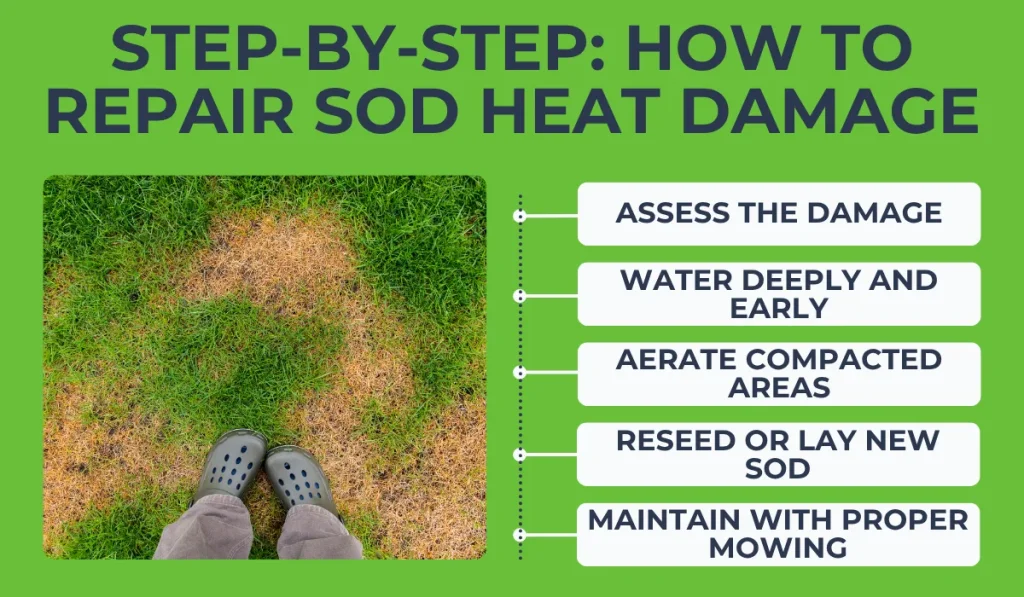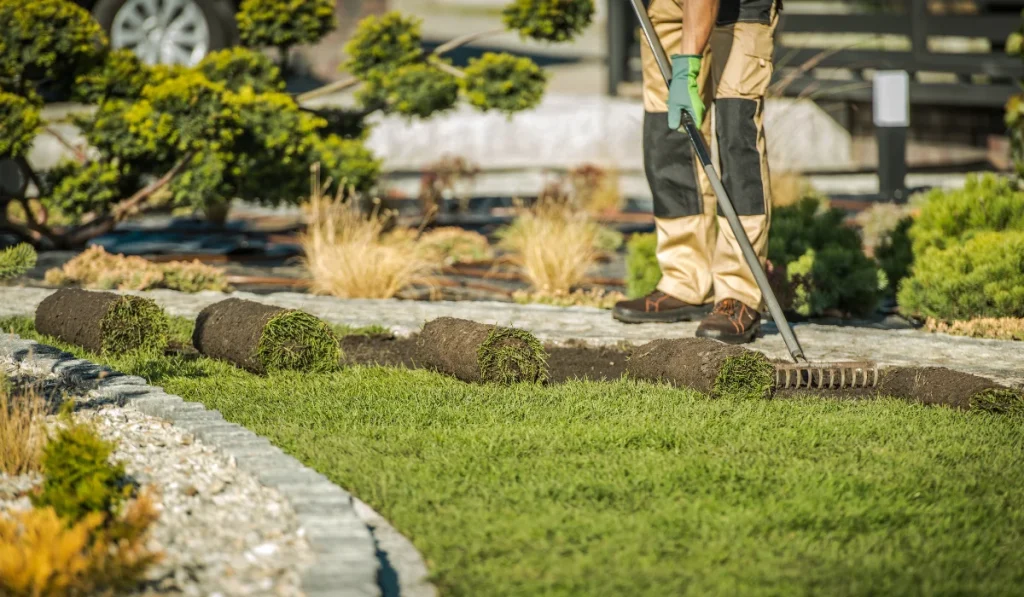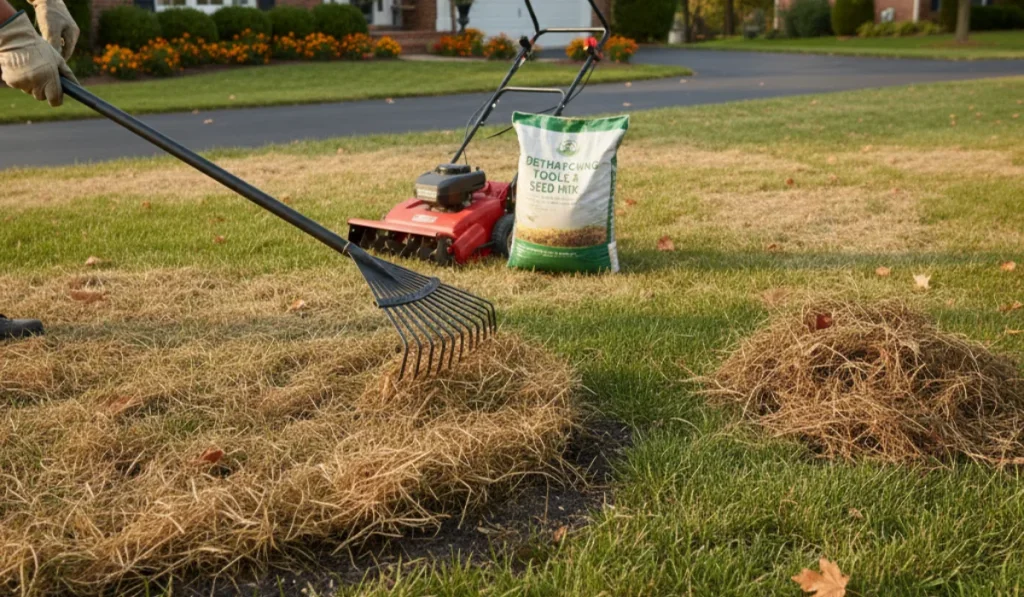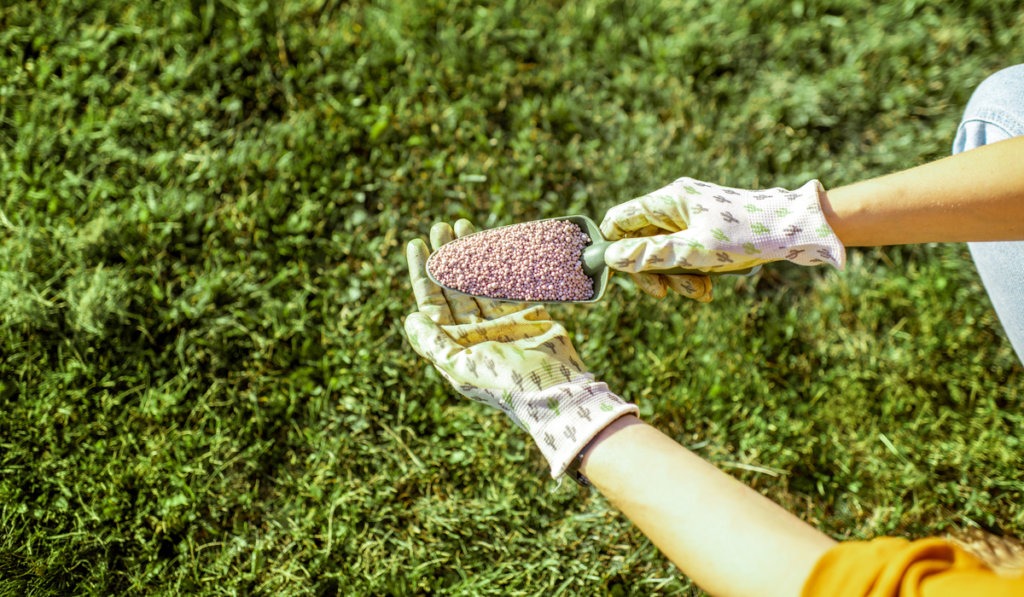California’s hot and dry summers can damage your lawn. If you’re seeing dry patches, brown patches, or thinning grass, you’re not alone. Many homeowners in California struggle to keep their lawns healthy and green due to the extreme heat.
The good news? A heat-stressed lawn isn’t always a lost cause. With proper care and timing, you can repair sod heat damage and revive your landscape.
In this guide, we’ll show you how to spot signs of heat damage on your sod and how to treat a heat-damaged lawn the right way. We’ll also help you prevent future heat damage. Whether you’re in Bakersfield, Sacramento, or somewhere in between, keep reading to learn how to keep your lawn healthy and green despite the summer heat.
Key Takeaways:
- Catch sod stress early: Look for signs like brown patches, wilting grass, and bare spots. These are signs of heat damage you can spot before it gets worse.
- Water smart: Deep watering in the early morning, about 1–1.5 inches of water per week, can help restore moisture and strengthen roots.
- Aerate and overseed: Loosen soil compaction and overseed damaged spots to promote thick, healthy grass growth.
- Choose drought-resistant sod: Use drought-resistant turfgrass like TifTuf Bermuda. This type of grass can better withstand California’s hot, dry climate.
Signs of heat stress and sod damage
When you know what a heat-damaged lawn looks like, you act fast to repair your lawn. Here are some common signs to look out for:
- Brown patches or dead grass: This is often a result of constant exposure to hot weather. Drought stress, not lawn diseases, usually causes these spots. The grass may turn yellow or brown and feel dry or brittle to the touch.
- Bare spots: Bare patches appear when the sod dies completely and leaves behind exposed soil. These areas won’t fill in on their own without reseeding or resodding.
- Wilting grass blades: Heat-damaged grass curls or lies flat, especially in the afternoon heat. This can indicate that your lawn needs deep watering.
- Patchy dormancy: Warm-season turfgrass like Bermuda may go dormant. However, dead patches won’t bounce back.
You may also see more grubs or fungal diseases in heat-stressed areas, especially where thick thatch prevents proper airflow and traps moisture.
Step-by-step: How to repair sod heat damage

1. Assess the damage
Not all brown grass is dead. Run your hand over the blades and check the crown at the base. If it’s white and firm, the sod is still alive. If it’s brown and brittle, you’ll need to patch or replace those areas.
2. Water deeply and early
Start watering your lawn in the early morning. Watering early helps the soil absorb moisture before the heat sets in. Provide about 1–1.5 inches of water per week during recovery.
Shallow watering during dry weather won’t do much for your sod’s root system. Your sod’s roots need more water during summer. Sprinklers can help with deep watering, allowing you to soak your sod’s root system at least 6 inches deep.
3. Aerate compacted areas
Heat-stressed lawns often suffer from soil compaction. Using a core aerator allows water, nutrients, and air to reach the roots more efficiently.
Aeration also breaks up thatch and prepares your soil for overseeding or sod repair.
4. Reseed or lay new sod
If you’re dealing with dead grass, reseed using a grass variety that matches your lawn and thrives in your region. Avoid planting cool-season grasses like bluegrass, as these types of grass don’t thrive well in hot weather. Look for drought-resistant or warm-season types instead so that you can enjoy a healthy lawn even in summer.
- For bare spots, overseed with a quality seed mix.
- Keep the soil moist to support germination.
- Lay new sod when temperatures are cooler or provide shade and water it deeply during establishment.
5. Maintain with proper mowing
Keep your mower blades sharp and mow at a higher height to avoid stress on the grass. Mowing high also protects the soil from drying out. Never cut more than one-third of the grass blade at a time.
Taller grass supports healthy grass growth and helps your lawn recover faster from heat damage.
Long-term lawn care tips to prevent future heat damage
Having a solid lawn care routine will keep your lawn healthy all year. Here’s how to reduce the chances of heat damage:
- Aerate your soil annually to minimize soil compaction and promote strong roots.
- Choose turfgrass varieties like TifTuf Bermuda that are drought-resistant and recover quickly from foot traffic and wear.
- Fungal diseases and grubs are more likely to appear when your grass is weak or stressed, especially during hot weather. Spotting these lawn-damaging bugs and diseases can prevent severe lawn damage.
- Avoid overfertilizing. Too much fertilizer encourages fast, shallow growth that can lead to thatch buildup, which can trap heat and lower drought resistance.
- Make infrequent deep watering a habit in the early morning during dry weather to minimize evaporation and encourage soaking.
- Overseed in fall to thicken the lawn and keep weeds from taking over.
If you’re in Southern California or the Central Valley, following seasonal lawn care tips like these can help you have healthy grass all year long.
Final thoughts
Repairing sod damaged by California’s summer heat takes more than just watering. It takes a clear plan and consistent care. Spot signs of stress early, improve soil health, and reseed or replace damaged areas with the right grass.
Understanding how your lawn responds to heat and drought is key to helping it bounce back. With the proper steps, you can turn a dry, struggling yard into a lush, resilient landscape.
Planning to replace or repair your lawn? Choose turfgrass that’s built to thrive in California’s climate. At SodLawn, we deliver premium, drought-tolerant sod varieties like TifTuf across the state.
Contact us today, and let’s work together to make your lawn stronger, greener, and ready to handle the heat.
FAQs
What’s the best time of day to water a heat-stressed lawn?
Early morning, before 9 a.m., is ideal. This timing reduces evaporation and gives the lawn time to soak up moisture before the day heats up.
Can I overseed during a California summer?
It’s better to wait until early fall when the heat starts to drop. Warm soil and mild air temperatures help new seeds grow strong roots.
What kind of grass works best for heat tolerance?
Choose drought-resistant grasses like Bermuda (TifTuf) or Zoysia. These warm-season grasses can handle high heat and dry conditions better than cool-season varieties.



